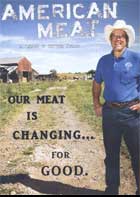
American Meat: Our Meat is Changing… for Good 2013
Distributed by Passion River Films, 154 Mt. Bethel Rd., Warren, NJ 07059; 732-321-0711
Producer n/a
Directed by Graham Meriwether
DVD , color, 85 min.
Sr. High - General Adult
Agriculture, Food
Date Entered: 04/11/2014
Reviewed by Marie Letarte Mueller, Director, Bigelow Free Public LibraryAmerican Meat could have been just another propaganda vehicle for the organic meat farming industry disguised as a film, but the director portrays fairly the current (commodity-based) practices versus family farming. The film is broken into three main sections: “The Current System,” “A Different Path,” and “Up to Us.”
The first part talks about commodity farming, specifically hogs and chickens and how American farming converted from traditional, family-owned operations to industrial farming. Like many industries in the 1950s and 1960s, farming increased efficiency: raising more animals faster, in smaller spaces. Along with the government’s practice of subsidizing corn (fed to the animals) and fossil fuels (used to fertilize the grain and transport the animals), this practice keeps food prices artificially low. Just a half-century ago, food was a much higher percentage of a family’s gross income than it is today.
The film delivers its message through interviews, mostly with pork and chicken farmers. Chuck Wirtz raises hogs in Iowa and really loves what he does. He spends his days walking through his pens with a hypodermic syringe, looking for sick pigs. In the commodity system, where pigs are raised indoors close together, they are more susceptible to illness.
Under this system, unless farmers can compete or work with the big industrial farms, they go out of business. Many previously-thriving communities in Iowa have been abandoned for greener pastures and better jobs because the profit margins for pigs have become smaller and smaller—until they’ve disappeared altogether.
Chicken farming, too, has been commoditized by industrial farms. Prior to the 1940s, chickens were kept mainly for eggs. But after WWII, they became an option for eating, thus the commodity chicken farm was born.
Most chicken farmers don’t own the chickens—they just care for them and raise them for the seven weeks between egg and edible chickens are sent off to the corporations that butcher and sell them. (The chicken brands familiar to many of us, Pilgrim’s Pride, Tyson, and Purdue, among them). However, they are responsible for building the barns and ensuring that the chickens don’t die. If an industrial chicken company chooses not to send a farmer chickens, he still has to pay for his barns and equipment.
This being said, the director shows his viewers the alternate route: grass-based farming. In this segment, different, smaller, family-owned farms are examined. Whereas commodity hogs live most of their lives indoors, grass-based hogs are, in some farms, herded like cattle, and in others, given the opportunity to wallow in manure as just one step in the nature-based growing cycle.
Like Michael Pollan did with his research for The Omnivore’s Dilemma (2006), Meriwether visits Polyface Farm in Virginia to get a sense of what a healthy, grass-based farm looks like. Joel Salatin has been farming for over thirty years and is cited as an innovator in the family-based farming community.
A film about American meat wouldn’t be complete without some mention of the slaughtering of animals. The director faces it without comment and without prejudice. Adopting the farmers’ attitude, slaughter of the animals is just a fact of life and, “Voilà! This is how we do it.” A family-owned farm like Polyface Farm slaughters up to six hundred chickens a day. Tyson, on the other hand, can do 100,000. Of course, Polyface’s chicken’s will cost more.
Although the commodity farmers are not vilified in any way, the feeling of the film is somewhat skewed toward the side of the small farmer—the grass-based farm. However, American Meat is a film worth watching—less sensational than SuperSize Me (2004), but, instead, food for thought on what Americans eat.